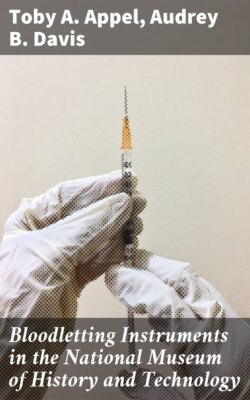Bloodletting Instruments in the National Museum of History and Technology

Реклама. ООО «ЛитРес», ИНН: 7719571260.
Оглавление
Audrey B. Davis. Bloodletting Instruments in the National Museum of History and Technology
Bloodletting Instruments in the National Museum of History and Technology
Table of Contents
PREFACE
BLOODLETTING INSTRUMENTS
IN THE. NATIONAL MUSEUM OF HISTORY AND TECHNOLOGY
AUDREY DAVIS and TOBY APPEL[A]
Introduction
Sources
Bleeding: The History
Cupping
Leeching
Veterinary Bloodletting
Physical Analysis of Artifacts
Catalog of Bloodletting Instruments
Footnotes
Footnote
LIST OF TRADE CATALOGS CONSULTED
Figures 26-124
REQUIREMENTS FOR SMITHSONIAN SERIES PUBLICATION
Отрывок из книги
Toby A. Appel, Audrey B. Davis
Published by Good Press, 2021
.....
The anatomist and physician Erasistratus (300-260 B.C.), was one of the earliest physicians to leave a record of why he opposed venesection, the letting of blood from a vein. Erasistratus, who practiced at the court of the King of Syria and later at Alexandria, a celebrated center of ancient medicine, recognized that the difficulty in estimating the amount of blood to be withdrawn and the possibility of mistakenly cutting an artery, tendon, or nerve might cause permanent damage or even death. Since Erasistratus believed that only the veins carried blood while the arteries contained air, he also feared the possibility of transferring air from the arteries into the veins as a result of venesection. Erasistratus was led to question how excessive venesection differed from committing murder.[4]
Through the writings of Aulus Cornelius Celsus (25 B.C.-?), the Roman encyclopedist, and Galen (ca. A.D. 130-200) venesection was restored as a form of orthodox medical treatment and remained so for the next fifteen hundred years. By the time of Celsus, bloodletting had become a common treatment. Celsus remarked in his well-known account of early medicine: “To let blood by incising a vein is no novelty; what is novel is that there should be scarcely any malady in which blood may not be let.”[5] Yet criticism of bloodletting continued, for when Galen went to Rome in A.D. 164 he found the followers of Erasistratus opposing venesection. Galen opened up discussion with these physicians in two books, Against Erasistratus and Against the Erasistrateans Dwelling in Rome. These argumentative dialectical treatises, together with his Therapeutics of Venesection, in which he presented his theory and practice of venesection, established Galen’s views on bloodletting, which were not effectively challenged until the seventeenth century.[6]
.....